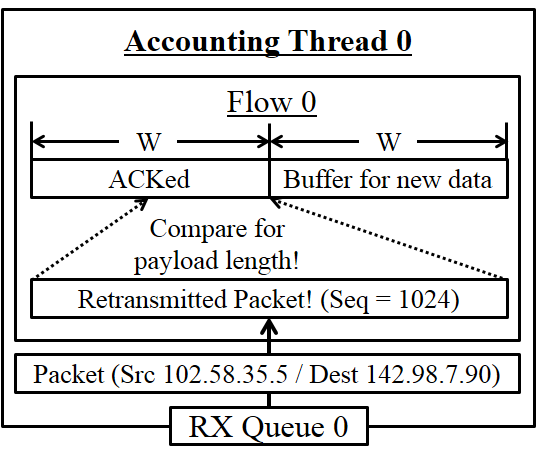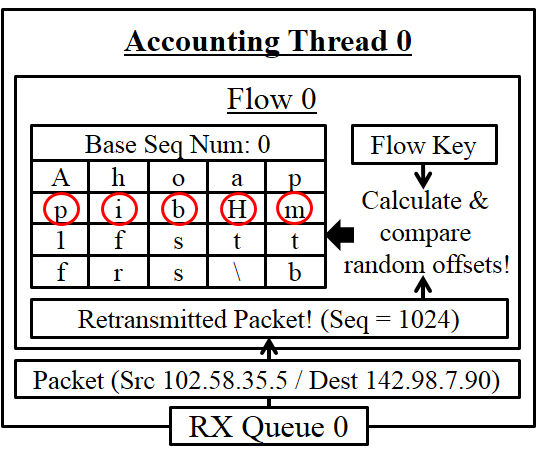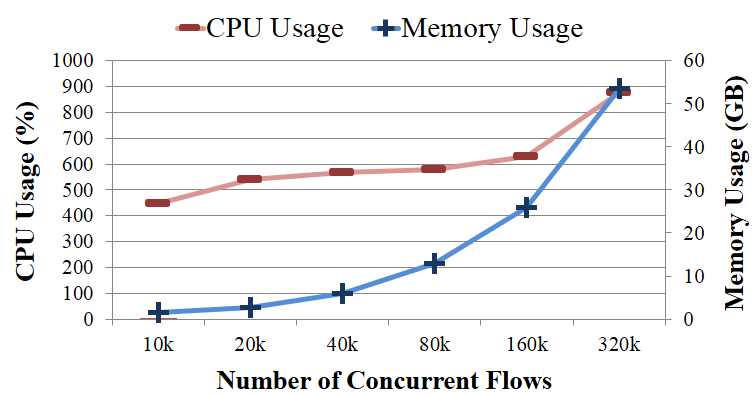TCP Retransmission Attacks on Cellular Traffic Accounting Systems
Packet retransmission is a fundamental TCP feature that ensures reliable data transfer between two end nodes. Interestingly, when it comes to cellular data accounting, TCP retransmission creates an important policy issue. Cellular ISPs might argue that all retransmitted IP packets should be accounted for billing since they consume the resources of their infrastructures. On the other hand, the service subscribers might want to pay only for the application data by taking out the amount for retransmission. Regardless of the policies, however, we find that TCP retransmission can be easily abused to manipulate the current practice of cellular traffic accounting.
| Free-riding Attack | Usage-inflation Attack |
|---|---|
|
This attack avoids accounting of the cellular traffic by tunneling the actual
payload in a fake TCP header that masquerades as packet retransmission.
As of November 2013, all Korean ISPs are vulnerable to this attack. |
This attack arbitrarily inflates the cellular data usage of a target subscriber
by intentionally retransmitting packets in the flow even without
actual packet loss.
As of November 2013, the majority of cellular ISPs (outside of South Korea) are vulnerable to this attack. |
Fundamental Difficulty
The fundamental challenge lies in detecting malicious TCP retransmission in the middleboxes (e.g., accounting systems). Middleboxes cannot reliably detect if a retransmitted packet is innocent (sent out of necessity) or malicious (sent even if there is no sign of packet loss) since they cannot precisely infer the TCP states of end nodes.
What is Abacus?
Abacus is a high-speed celluar data accounting system that runs on commodity PCs to monitor and account for packets flowing through the cellular network. It effectively exploits the Deep Packet Inspection (DPI) of all packets to accurately distinguish between legitimate and malicious TCP retransmission packets and prevents "free-riding" attack.
Abacus Design
Abacus runs DPI on the retransmission packets to detect tunneling attacks. Abacus extends Monbot, a highly-scalable flow monitoring system on commodity hardware, to drastically reduce the flow buffer requirement by probabilistically verifying the payload of retransmission packets. Abacus has two modes: deterministic and probabilistic.
|
|
|
Deterministic DPI (d-DPI)
Buffer the original payload and conduct byte-by-byte comparison
with the retransmitted payloads.
-
Buffer management: We set largest sequence number Abacus
has seen from one end as S. We estimate the maximum send window
size as the receive window size, W, advertised by the receiver.
Normaly Abacus buffers:
Any sequence numbers ≥ (S - W)
However, W could change on every ACK and packets can be delivered out of order in practice. So, we decide to buffer:
Any sequence numbers ≥ (S - 2 x W)
As S advances, we slide the flow buffer window to monitor the right window range.
Probabilistic DPI (p-DPI)
Sample the original payload (n bytes per each 1024-byte flow data
at random) and check whether retransmitted payloads have the
identical values for the sampled data.
- Buffer management: We allocate a flow table per each flow direction that consists of a set of sample entries. Each sample entry has a 4-byte base sequence number (bsn) and n-byte sampled data. Each sampled byte on the entry is randomly chosen from the sequence number space of [bsn, bsn + 1023].
- Sampling random bytes: The locations are determined by running a hash function with (per-flow secret key, bsn for the entry) as input. The per-flow secret key is generated by HMAC_secret key{nonce} at connection setup time where the nonce is a 8-byte random number generated per each flow and the secret key is the system-wide key known only to Abacus. Any hash function is fine as long as its output size is (10*n) bits or larger.
Performance
All machines are connected to a 10 Gbps Arista 7124 switch. Abacus monitors all the packets exchanged between the server and the client via port mirroring.
- Custom HTTP server: dual Intel Xeon E5-2690 CPUs (2.90 GHz, octacore), 64 GB of physical memory, and an Intel 10G NIC with 82599 chipsets.
- Traffic generator: dual Intel Xeon E5-2690 CPUs (2.90 GHz, octacore), 64 GB of physical memory, and an Intel 10G NIC with 82599 chipsets.
- d-DPI: dual Intel Xeon E5-2690 CPUs (2.90 GHz, octacore), 64 GB of physical memory, and an Intel 10G NIC with 82599 chipsets.
- p-DPI: Intel i7-3770 CPU (3.40 GHz, quadcore), 16 GB of physical memory, and a 10G NIC.
|
|
|
d-DPI: d-dDPI works well up to 160K concurrent flows but it starts to drop packets at 320K flows. The memory usage grows linearly with the number of flows, showing 25.9 GB at 160K flows and 53.6 GB at 320K flows. In case of CPU usage, d-DPI stays at 500% to 600% (where, 100% = 1 CPU core is fully utilized) most time but it grows to 876% at 320K flows, presumably due to the bottleneck in the memory bandwidth.
p-DPI: p-DPI does not drop any packet even with 320K concurrent flows. The memory usage is 391.0 MB at 320K flows and 202.7 MB at 160K flows. The CPU usage of p-DPI stays under 100% even at 320K flows. This indicates that Abacus in p-DPI mode can monitor a large number of flows that saturate 10 Gbps even on a low-powered desktop machine.
Press Coverage
- KAIST Breakthroughs - Spring 2015
- KAIST EE Research Achievement
- Daily Secu News Article
- Digital Daily News Article
Publications
- Gaining Control of Cellular Traffic Accounting by Spurious TCP Retransmission
Younghwan Go, Jongil Won, Denis Foo Kune, EunYoung Jeong, Yongdae Kim, and KyoungSoo Park
In Proceedings of the 21st Annual Network and Distributed System Security Symposium (NDSS 2014)
San Diego, CA, USA, February 2014 - Impact of Malicious TCP Retransmission on Cellular Traffic Accounting
Younghwan Go, Denis Foo Kune, Shinae Woo, KyoungSoo Park, and Yongdae Kim
In Proceedings of the 5th Annual Wireless of the Students, by the Students, for the Students Workshop (S3 2013)
Miami, FL, USA, September 2013 - Awarded Best Paper - Towards Accurate Accounting of Cellular Data for TCP Retransmission
Younghwan Go, Denis Foo Kune, Shinae Woo, KyoungSoo Park, and Yongdae Kim
In Proceedings of the 14th International Workshop on Mobile Computing Systems and Applications (HotMobile 2013)
Jekyll Island, GA, USA, February 2013
People
Students:
Younghwan Go,
Jongil Won,
Denis Foo Kune, and
EunYoung Jeong
Faculty:
KyoungSoo Park and
Yongdae Kim





